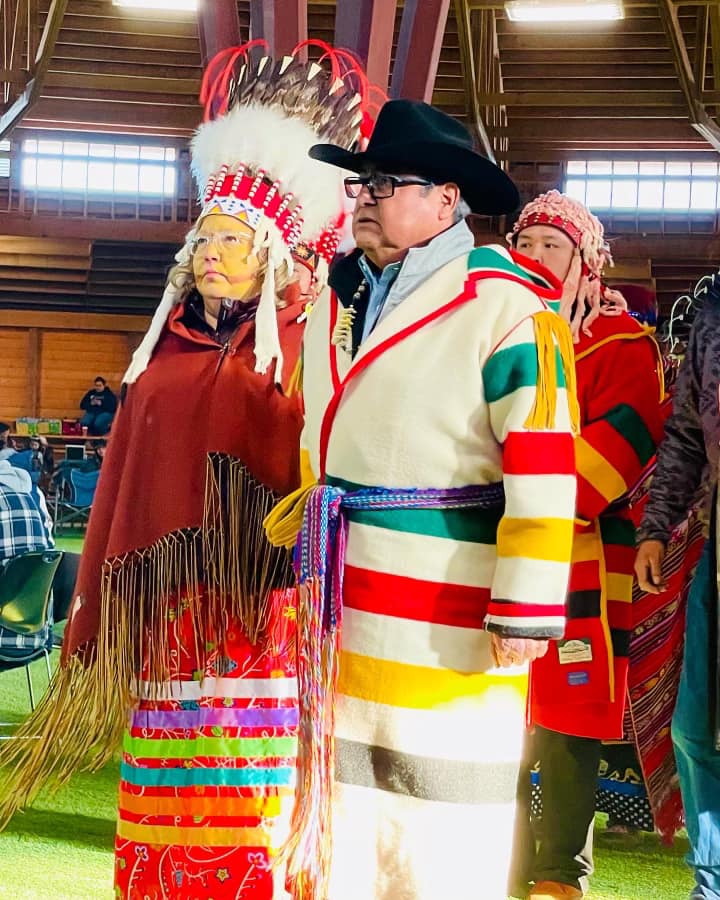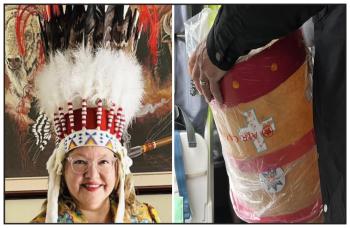Image Caption
Summary
Local Journalism Initiative Reporter
Windspeaker.com
When Assembly of First Nations National Chief Cindy Woodhouse Nepinak was checking in for her Air Canada flight from Montreal to Fredericton, N.B April 24, the ceremonial headdress she was carrying in its case was not a problem.
It wasn’t a problem when she boarded the flight, either.
“Then I put my headdress under the chair in front of me, as usual. Just standard stuff, right?”
It became a problem when a flight attendant made it a problem.
“That’s when it escalated,” she told Windspeaker.com.
Another flight attendant joined in and tried to tell Woodhouse Nepinak that she needed to put the sacred item into checked luggage in the underbelly of the plane with the cargo. The headdress had been bestowed on the national chief in ceremony by the Pikanii Nation of the Blackfoot Confederacy in commemoration of her role in negotiating an historic multi-billion-dollar child welfare settlement with Canada.
“I told her, ‘We can't check it. What do you want me to do?’ I said, ‘Do you want me to get off this plane’?”
With the scene attracting an audience of everyone on the plane and the situation becoming tense, Woodhouse Nepinak said she “was kind of in a daze, I guess. Shook up or something, I didn't know what to do” in response to the disrespect the flight employees were treating an item of such iconic Indigenous significance.
“Because in that moment you kind of feel alone and there's a hundred people watching you,” she said. “It was terrible. And it was humiliating because a big plane of people watching, it's not comfortable.”
The national chief’s staff were trying to talk to the flight crew and trying to reason with them and were threatened in return, Woodhouse Nepinak said.
“You have to be careful on airplanes. You'll end up in jail,” she said.
“I knew that and I was just taken aback and it was worrisome and scary at that moment.”
“But I knew that I didn't want to be separated from my headdress either.”
The headdress and case were put in a plastic bag and were about to be taken off the plane and then the national chief stopped them.
“I pulled off the plastic bag. I opened it. Pulled out my headdress and I kept it with me on my seat.”
“If she would've grabbed it from me, I don't know what would've happened.”
She wants to thank the Canadians on the flight who stepped in to try and help.
“They were pretty horrified,” she said. “They didn't stand by and stay quiet.”
“The Canadians were pretty upset. And they offered me some food after and something to drink and lots of kind words. They were so embarrassed. People were just taken aback by it.”
Other passengers were trying to help, telling the stewards to “leave her stuff alone. They were trying to help,” Woodhouse Nepinak said. “They knew that it was wrong. And they must've heard these stories before, unfortunately.”
Although the media have been circulating updates that Air Canada has issued an apology to the national chief, as of Windspeaker’s interview with her late this afternoon, she hadn’t received one, Woodhouse Nepinak said.
“It’s nice it’s in the media. It’d be nice if I’d seen it. AFN hasn’t seen it yet,” she said.
“I wrote to Air Canada and then Wednesday evening tried to reach out to them,” and she was redirected to their regional carrier Jazz.
“And then they sent me back a 15 per cent discount email,” she says. “That's not acceptable.”
The story travelled quickly on social media, sparking outraged posts.
Then Air Canada had representatives calling her. “They tried to get other people to call me yesterday, but I said, ‘Unless it's the president or the chairman of the board, I don't want to talk to anybody else’.”
When the president called, she says, “I told him a few things.”
“I asked him to put a mandatory First Nations board member on the Air Canada Board of Directors.”
She asked the airline for a “protocol for First Nations. Develop one, let's work on one.”
She also asked for cross-cultural training for all of their staff.
She’s said she wanted a “face-to-face meeting with some of our Knowledge Keepers, and their board of directors. And I've also called for a circle of advisors. And so I hope we can work on some of those low hanging fruit.”
The national chief said “I know change is always difficult, but I think it's necessary.”
“Sometimes these things happen and they're not easy conversations to have. They're not conversations that you want to have,” she said.
“But I think if we implement some of these changes right away, I think it'll be helpful,” Woodhouse Nepinak said.
“I hope I can go onto planes again. I don't think I'm going to travel next week, just feeling apprehensive about it. I have to find a way of being safe on an airplane, and if I can take my own headdress with me without feeling like I have to be careful each time.”
She was reminded of when the Assembly of Manitoba Chiefs sued the Canadian Air Transport Security Authority through the airlines. “They had won on the Employment Equity Act. They sued them for human rights,” she said.
“The airlines and CATSA was to start reflecting the Canadian mosaic, if you will, that there would be a make-up of First Nations people hired, people of colour and the demographics of the country.”
“They were supposed to give yearly reports on that. I'm not sure where that is now,” she said.
“But I think things like this happen to remind us that we have to continue to do better, and that we can't give up on sensitivity training and trying to move forward in a better way.”
Spiritual significance

Woodhouse Nepinak explains that the headdress has spiritual significance and prayer plays a role in her work as national chief.
“We pray to give me strength and guide me along my path to try and live a better life. Every day, every day. All of us, as people, we want to strive to be better.”
The headdress is a reminder of that, she said. “And it's a reminder to know that when I speak, to try my best to speak well, to represent First Nations people, to remind me of the prayers of that day and the people that I represent. And to wear it with pride and dignity.”
“To try to be a good person every day and to remember to pray every day and that God is with me, that people's prayers are with me to try and live a good life.”
She said that’s not always easy.
“I am far from perfect, like everybody else, but I always want to strive to be better than I was even a year ago.”
Receiving the headdress reminds her that she has a big responsibility, she said. “And so for somebody to try and meddle with that, and push and pull that away from me is not something I ever want to live through again.”
As a little girl she saw headdresses for the first time when she was four at a chiefs assembly. “I'd seen them then, and I remember that it was our leaders and that it was the work that we were doing that we would fight for a better life for our people,” she said.
“Of course, growing up on a First Nation community, I already knew back then as a little girl that things were different. On and off reserve– the disparities.”
“I think that's what the headdress represented, that we would try our best to live a better life,” said Woodhouse Nepinak.
Local Journalism Initiative Reporters are supported by a financial contribution made by the Government of Canada.

